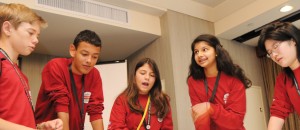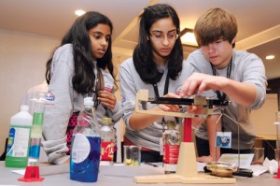Young scientists work together and win
Broadcom MASTERS competitors qualified with individual projects, but won based on team challenges

Guests checking into the posh Palomar Hotel in Washington, D.C., recently, might have been surprised to hear pounding footsteps, shrieks and laughter pouring out of a conference room late one evening. And they would have been even more surprised to see what was behind those doors: 30 of the nation’s top middle school science students, flushed and sweaty, playing dodgeball, riding piggyback on their parents and squirting one another with water bottles.
The students were finalists in the first Broadcom Math, Applied Science, Technology and Engineering for Rising Stars — or MASTERS — challenge. The three-day competition kicked off with an evening of icebreaking and team-building activities meant to help these students from throughout the United States and Puerto Rico get to know each other.
It may have looked like all fun and games. But the purpose of these activities was to get students comfortable working in teams to solve problems creatively and to accomplish a shared goal.
“We know these kids are smart, but getting together with others and innovating is another skill set entirely,” says Paula Golden, executive director of the Broadcom Foundation, in Irvine, Calif., which cosponsored the MASTERS program with Society for Science & the Public, in Washington, D.C., publisher of Science News for Kids. “One of our goals is to integrate that team approach. It takes a village to innovate, and science isn’t done in a vacuum,” she explains.
To qualify, students took part in a science fair affiliated with Society for Science & the Public last spring. Teachers and fair organizers then nominated promising students to apply for one of the prestigious slots as a Broadcom MASTERS finalist.
What sets this new program apart from a traditional science fair is its emphasis on teamwork. Finalists were judged not only on their individual science fair projects but also on how they demonstrated leadership and creative problem-solving while working as part of a team during a series of group challenges.
“You tend to get very siloed in a science fair competition,” Golden says. “A science fair is all about you. Our goal is to give these kids insight to broader fields and to learn how to tap their colleagues for ideas.”
This focus on group activity mirrors the way science is done in the real world, competition organizers say.
“No scientist works alone anymore,” observes Bill Wallace, a science teacher at Georgetown Day School in Washington, D.C. A former biologist at the National Institutes of Health, he served as a judge for the team challenges.
“We think learning to work as part of a team will be very important as students move ahead.”
Finalist Maria Elena Grimmett, 12, of Jupiter, Fla., agrees. “If we learn to work well as a group, it’ll help us to work together as a community in the future.”
Perhaps even more important than practicing how science works, says Golden, is introducing students to teamwork at the age when they are first beginning to form their own identities and to choose those students who will become their friends. Adolescence, she says, is a time when students actively seek out a “tribe,” or group of like-minded people to belong to.
“By teaching kids the benefit and joy of collaboration at a time when finding common ground is so critical, we may help them identify groups of young people with common vision and potential,” she argues.
Of course, teamwork comes with more concrete benefits as well. It empowers students to tackle a project that would overwhelm an individual. In groups, students can pool their strengths. That proved a plus when the young researchers were charged with projects that ranged from building a suspension bridge and wiring a model house to designing and building a Rube Goldberg machine, a device that’s deliberately overengineered to complete a simple task.
When Ria Chhabra, 14, of Plano, Texas, came to the competition’s Science Relay — a set of six different experiments to be completed in 90 minutes or less — she was initially intimidated.

“When I first saw the challenges, I thought, there’s no way,” she recalls. “But when you start to do them together, you realize there’s more you could do than you thought. We really pushed ourselves more than we could have imagined.”
Teammate Mahita Tovinkere, 12, of Portland, Ore., agrees. “When we first came in, I didn’t think I knew how to do any of them and I thought I’d just follow the others. But when I actually took part in it, it was fun. And it was easier because I was confident.”
“If we split up and do our parts, then everyone can contribute and we’ll get it all done,” Anirudh Jain, 13, of Portland, Ore., told his teammates during their challenge to develop a campaign to persuade politicians about the benefits of alternative energy.
It’s a point that the competition judges didn’t miss.
“The most successful teams are the ones that came up with a plan and then divided up the work,” says judge Amy Kruse, executive director of the neuroscience division at the software company Intific. “Because of the time constraints behind all the group challenges, everybody can’t work on the whole thing at once. They need to break it down.”
But many students acknowledged it’s not always easy to collaborate, especially when people with strong opinions must interact.
“In science class, working in groups, one kid usually stands out as the leader,” says Katherine Landoni, 14, of Sequim, Wash. “But here, we are all leaders,” so the trick becomes how to decide whose ideas to use and how to figure out which team members should implement them, she says.
Indeed, explains Stephanie Lemnios, who manages the competition for Society for Science & the Public, “Being a good team member is not just about sharing your ideas, but respecting other peoples’ perspectives and working together. For some students, this is a very new concept,” she says. Those who may be used to always being the smart kid in class may not have felt compelled to listen carefully to their peers. But listening to and respecting the suggestions of others —“that’s an important part of teamwork.”
During some team projects, judges intervened to make sure one student wasn’t dominating his or her group, and to ensure that the ideas of quieter team members were heard and considered.
Sometimes judges also stepped into the role of coaches, offering suggestions to teams that found collaboration a struggle, notes Meagan Bethel, 14, of Tucson. “Our team wasn’t working well together on one of the challenges,” she says. Then a judge provided some hints on how they might cooperate more effectively. “We tried really hard to follow his advice to not be too controlling and to let other people say things,” she says. “And our challenges after that went better.”
Carolyn Jons, 13, of Eden Prairie, Minn., learned about the importance of trusting in her group members’ abilities. “We’ve all heard 500 times about how we need to be able to work together so we can do our best — but these activities really showed it,” she says.
A side benefit to all of this sharing and collaboration: Most students went home with a new group of friends. And that can be empowering.
“Students who are deeply immersed in something, especially at a young age, can feel isolated socially, because it can separate them from their peers,” says Elizabeth Marincola, president of Society for Science & the Public and publisher of Science News for Kids.
“The intellectual aspects [of science] are just as important as the social aspects of finding each other,” she maintains.
It’s a sentiment many finalists shared.
“This competition is motivating, but it’s really nice to meet new people,” says Jordan Kamimura, 14, of Hilo, Hawaii.
Mahita Tovinkere found that the students she worked with were so nice that “I don’t feel like we’re in a competition.” To her, they became simply colleagues.
The MASTERS program also met another important need for many science and engineering students: interacting with kids who share their interests and who did not criticize them for being smart.
“Science is usually classified as nerdy,” maintains Benjamin Hylak, 14, of West Grove, Pa., who placed second overall in the competition. “But here, there are no stereotypes. Everybody is used to being the smart kid who does all the work,” he continues. “So to have real teammates and people backing you up is amazing.”
Indeed, adds Daniel Feeney, 15, of Woodside, Calif., during the Washington program “we were really allowed to just be ourselves. We could all let out our inner nerds.”
“This is the beginning of the rest of your life,” Golden told the students. “The beginning of friendships you’ll have for the rest of your life — they will define you, they will support you, and you will very likely cross paths again in your professional careers.”
That observation certainly resonates with first place winner Feeney, who says, “Some of the friends I made here I’ll keep forever.”
The Broadcom MASTERS competition is cosponsored by Society for Science & the Public, publisher of Science News for Kids.